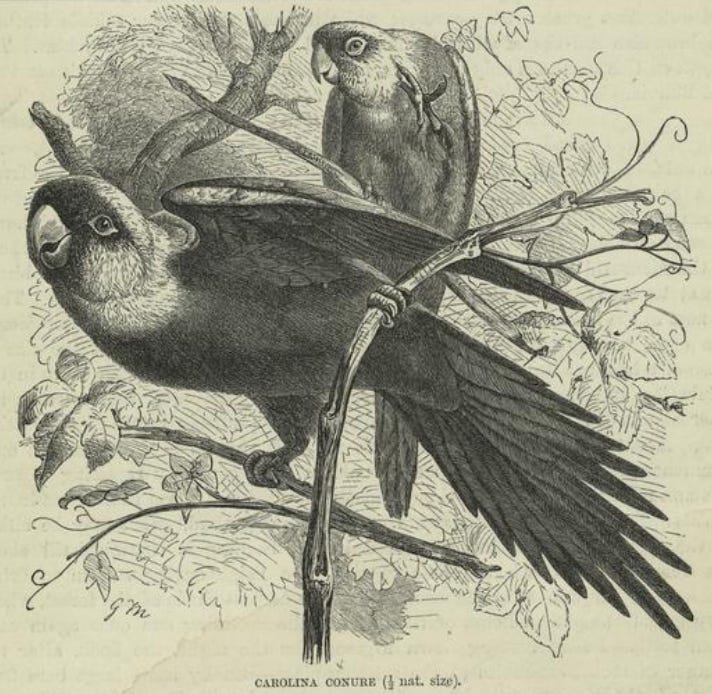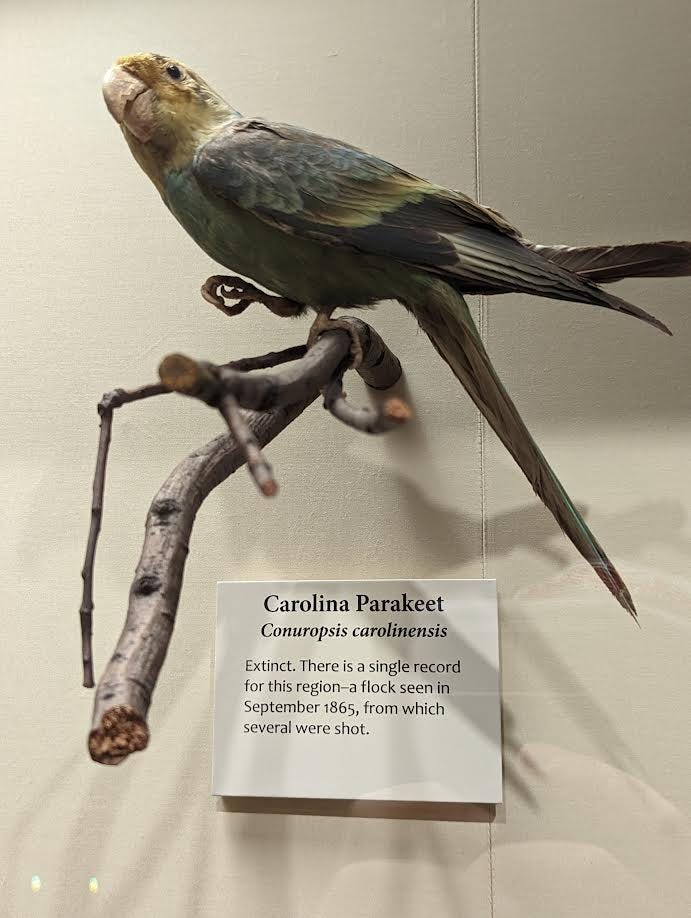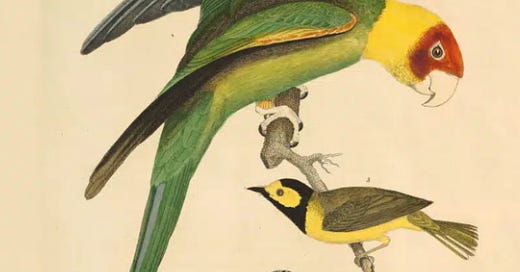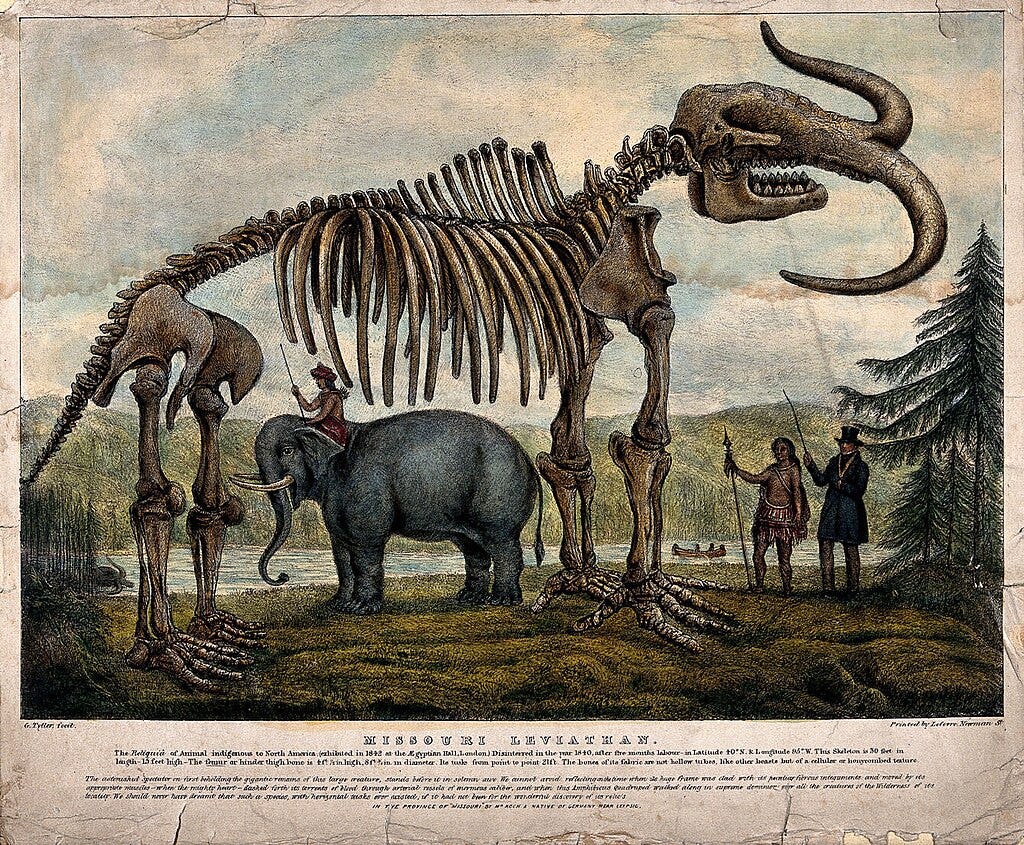At the northern tip of Kentucky there’s a mineral spring called Big Bone Lick. Some of the earliest Europeans to arrive at the spring found massive bones sticking out of the mud, left by enormous animals that had evidently gotten stuck while licking up the salty water that the spring brought to the surface (to be clear, the bones were familiar to the local Shawnee for generations). Amazed by what they’d found — a single molar weighing four pounds, a femur ten inches thick — the explorers sent the bones to experts in Paris for their analysis.
The bones clearly belonged to an elephant, or at least something elephant-like. But North America was not home to any elephants in the 1750s, and they were different enough from the bones of African elephants to conclude that they belonged to a separate species. The conventional wisdom was that all animals held an indispensable role in the economy of nature, stretching back to the Creation. It had not occurred to anyone that an animal formed by God could ever be destroyed. But after examining the mammoth bones and concluding that whatever animal left them behind no longer roamed the earth, the pioneering French naturalist Georges Cuvier came to the revolutionary realization that it might be possible for a species to go extinct.
In 1810, America’s first ornithologist, Alexander Wilson, paid a visit to Big Bone Lick. He was undertaking a vast project to paint every one of the country’s birds, and on that day his subject was America’s only native species of parrot, the Carolina Parakeet. The mammoths and cave bears and giant sloths that had until recently gathered at the lick were no more, but the salty spring still reliably attracted other animals looking for a nutritional supplement.
While waiting near the spring, Wilson saw a large flock of the parrots come “screaming through the woods in the morning, about an hour after sunrise, to drink the salt water, of which they, as well as the pigeons, are remarkably fond.” So many of these colorful birds landed near Wilson that the ground seemed to be “covered with a carpet of the richest green, orange, and yellow.” The flock then moved in one mass to a tree, “covering almost every twig of it, and the sun shining strongly on their gay and glossy plumage, produced a very beautiful and splendid appearance.”1

Wilson’s description of these birds is unfortunately the most vivid one we’ll ever get. A hundred years after he painted this scene, Carolina Parakeets would be as extinct as the mammoths that gave Big Bone Lick its name, leaving our country destitute of parrots. I’m going to save the story of how they went extinct for another time. For now, I want to focus on the Carolina Parakeet in life. What was it like to share a world with these remarkable creatures?
Beak to tail, Carolina Parakeets were about a foot long, and it would take stacking three of them together to make a pound. Each one was a little bigger than a mourning dove, but far more flamboyant. The lime-green parrots with their lemon-yellow heads and grapefruit-red faces got their name from the place where the naturalist Mark Catesby first encountered them in the 1720s, although if he’d traveled a little further afield he might have called them Louisiana, Indiana, Nebraska, or Iowa Parakeets instead. The birds covered almost the entire Eastern U.S., ranging south to Florida and Texas, west to Colorado, and reaching as far north as Michigan.
Throughout their range, parakeets gathered in the woods on riverbanks, in sycamore bottomlands, and within impenetrable cypress swamps. The birds blended so seamlessly with the forest greenery that an entire flock would virtually disappear when it landed in a leafed-out tree. One 19th-century writer described how, gun in hand, he was watching a flock circle overhead, waiting to get a good shot at them. When they abruptly landed in a tree, he could not “see so much as a feather of the desired game although [he] walked around the tree several times and even went beneath its branches to peer up between them.”2
What was remarkable about these birds, though, was that they stuck around once the leaves fell from the trees. Parrots are tropical birds. Nearly all of them live in areas where it’s balmy year-round. Not so the Carolina Parakeet, whose green feathers were as conspicuous in winter as they were camouflaged in summer. Alexander Wilson once saw a flock flying and squawking through a February blizzard along the banks of the Ohio river. And in 1780, a large flight of the birds landed near Albany in the middle of winter, which so alarmed the “more ignorant Dutch settlers” that “they imagined, in dreadful consternation, that it portended nothing less calamitous than the destruction of the world.”3
The agile birds flew in compact flocks and effortlessly darted through forest branches “with perfect ease,” all the while “screaming in a general concert.” They kept up this screaming the entire time they were airborne, much to the chagrin of humans within earshot, which could be as far away as a mile. One writer called their calls “shrill and disagreeable, a kind of grating, metallic shriek” that could continue for minutes at a time.4
Once they settled into a tree they’d quiet down pretty much at once and transition to a “low, continuous chattering among themselves, as if conversing in a social manner.” They’d keep up this banter while hanging upside down from branches, nimbly extracting seeds from pine cones or climbing from twig to twig, all “without interrupting the flow of gossip.”5

Most parakeets seemed to be left-footed, preferring to hold their food in their left claw while balancing on or dangling from the right. Watching the birds eat thistle seeds this way was, according to one writer, “a most beautiful and animated sight; one is almost persuaded not to disturb them.” The parrots flew from one plant to the next, “skillfully dissecting the thistles they held in their feet, biting out the milky seed while the released fluffy down floated away beneath them.” All the while they kept up their “loud conversational murmur of half articulate, querulous notes and calls.”6
The birds always traveled in large, raucous flocks, and roosted in groups as well. Thirty or more might pack closely together in the cavity of a large, hollowed-out sycamore, clinging to the sides of the trunk. Their habit of cuddling closely together might have helped them withstand below-freezing temperatures.
Each parrot had a personality, and they knew and cared for each other as individuals. One writer talked about how they “seem to caress and scratch each other's heads with all the fondness and unvarying friendship of affectionate doves.”7 Yet as is so often the case, the intelligence, curiosity, and communal care that served the parakeets in the wild became a deadly liability when met by humans who carried firearms and considered the birds nothing more than an easy meal or pest.

Wilson traveled to Big Bone Lick to study birds, and in his day, that meant killing them. He aimed his shotgun at the cheerfully chattering birds and sent a blast of birdshot into the crowd, killing several and wounding many more. He describes what happened next:
“The whole flock swept repeatedly around their prostrate companions, and again settled on a low tree, within twenty yards of the spot where I stood. At each successive discharge, tho showers of them fell, yet the affection of the survivors seemed rather to increase; for after a few circuits around the place, they again alighted near me, looking down on their slaughtered companions with such manifest symptoms of sympathy and concern, as entirely disarmed me.”
Whenever one of their number was killed, Carolina Parakeets gathered around the body rather than flying to safety. Wilson put down his gun before he’d killed the whole flock, but this restraint was not the norm. When people started shooting the hysteric, writhing flocks of birds, whether for their meat, their feathers, to protect their crops, or just for fun, they rarely stopped until every parrot was dead. This communal drive had undoubtedly served the species well for millions of years, but it was incompatible for life alongside Americans with guns.
Stay tuned for my next post, where I’ll talk about how humans and Carolina Parakeets lived alongside each other, and how this ultimately drove the parrots as extinct as the mammoths at Big Bone Lick.
Wilson, Alexander. American Ornithology: Or, the Natural History of the Birds of the United States. Illustrated with Plates Engraved and Colored from Original Drawings Taken from Nature. Vol. I. United States: Bradford & Inskeep, 1808.
Bent, Arthur Cleveland. “Life Histories of North American Cuckoos, Goatsuckers, Hummingbirds, and their Allies: Carolina Parakeet. Bulletin. United States: U.S. Government Printing Office, 1939.
Barton, Benjamin Smith. Barton's Fragments of the Natural History of Pennsylvania. United Kingdom: Taylor & Francis, 1799.
Snyder, Noel. “The Carolina Parakeet: Glimpses of a Vanished Bird.” Princeton, NJ: Princeton University Press. 2004; Cassell's Natural History. The Feathered Tribes. London: Cassell, Petter, & Galpin. 1863; Bendire, Charles. “Life Histories of North American Birds, from the Parrots to the Grackles.” United States: U.S. Government Printing Office, 1895.
Snyder, Noel. “The Carolina Parakeet: Glimpses of a Vanished Bird.” Princeton, NJ: Princeton University Press. 2004.
Bent, Arthur Cleveland. “Life Histories of North American Cuckoos, Goatsuckers, Hummingbirds, and their Allies: Carolina Parakeet. Bulletin. United States: U.S. Government Printing Office, 1939.
Cassell's Natural History. The Feathered Tribes. London: Cassell, Petter, & Galpin. 1863.





